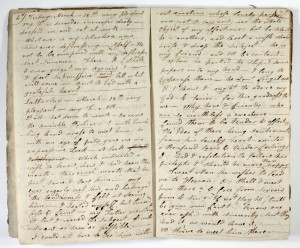With wedding season upon us, and love and relationships at the forefront of many minds this time of the year, it’s fun to wonder what courting, love, and relationships were like, and how they’ve evolved over the past couple hundred years. We all have ideas in our minds, probably placed there through novels and films. I know my stereotypical view of love in the 18th and 19th century always looks like a Jane Austen novel, and is either overly formal or overly dramatic.
The diary of Martha “Patty” Rogers, in AAS’s manuscript collection, proves to be an interesting look at love, and life, in the late 18th century. Patty’s diary is unlike many diaries of the time, with their simple recordings of the weather and the day’s activities. Patty did not hold back her emotions, and wrote extensively about her daily life, and included all the wonderful details that help make life back then much more relatable to us today.
I’ve transcribed one of my favorite entries from Patty regarding love below. On Saturday, March 19th, 1785, Patty ran into an ex, “Portius,” whom she appeared to still have feelings for –
I with trembling hand [?] to meet him – he with an eye of pity, gave me an expansive look – A look of soft intelligence which indicated a wish to know how I had been this month – this cruel month, that has passed, since I saw him – my eyes eagerly met his and betrayed the tenderness I felt at seeing him. – I seated myself but turned pale and faint…I could not bear to see him without emotions, whose lovely person once (not to say now) was the whole object of my affection – but be silent he is anothers…He is my friend, and I’ll be content.
Quite beautifully written, the true emotion and pain of encountering an ex, especially one who still has a hold on her heart, comes through in Patty’s writing. And how familiar is this scenario to us today? Almost anyone can relate to the feelings Patty is conveying, and this is what really brings Patty into the present, and what helps us see how little has changed over the centuries.
The courtship process may have been different, perhaps more formal, more reserved, but the feelings people had for one another, and the emotions brought upon by relationships – the excitement, the pain, the passion, the joy – all remain the same. Ah, love is (and always has been) a splendid thing.
If you’re interested in learning more about Martha “Patty” Rogers, there are additional resources at AAS, aside from her diary, that shed light on her life. Linda Kerber features Patty and her diary in her book, Women of the Republic: Intellect and Ideology in Revolutionary America (link to catalog record.) Also, it is believed that Patty may have been the model for the character of Dorcasina Sheldon in Tabitha Tenney’s novel Female Quixotism (link to catalog record), written in 1801. Finally, you can learn more about Patty and her family through the Roger’s Family Papers (link to catalog record.) This collection features not only Patty’s diary, but the diary of her father, Daniel Rogers, as well as family correspondence.

